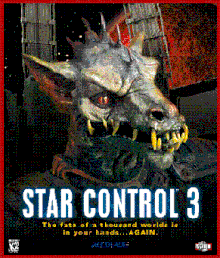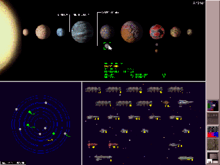Star Control 3
| Star Control 3 | |
|---|---|
 Cover art of the DOS version | |
| Developer(s) | Legend Entertainment |
| Publisher(s) | Accolade |
| Director(s) | Michael J. Lindner |
| Producer(s) | George MacDonald |
| Designer(s) |
Jim Tyler Mark Poesch |
| Programmer(s) |
Michael J. Lindner Mark Poesch Glen R. Dahlgren |
| Artist(s) |
Heather Capelli Michael J. Lindner Steve Riley |
| Writer(s) |
Daniel Greenberg Michael J. Lindner |
| Composer(s) | Andrew Frazier |
| Platform(s) | DOS, Mac OS, Windows |
| Release | 1996 |
| Genre(s) | Real-time strategy |
| Mode(s) | Single player, multiplayer |
Star Control 3 is a video game developed by Legend Entertainment. Legend were hired by Accolade to create a sequel to Star Control II when the original creators Toys For Bob expressed no interest in creating the sequel with the same budget as Star Control II (which left them working without pay for several months). It was released for DOS and the Macintosh in 1996, and re-released in 2011 with Windows support on GOG.com.
Gameplay

The game uses a 2.5D form of melee combat, but 2D combat is still available. However, unlike Star Control II, all ship designs absent from the story mode were omitted (with the exception of the Arilou). The module tunes of the second game were replaced with MIDI music, and pixel animations for communication with aliens were replaced with rendered and digitized 2D graphics of live puppets.
The gameplay is a mix of borrowing the melee combat and alien encounter dialogue trees from Star Control II, with new colony management elements[1] which could be compared to Master of Orion, but usually aren't. Star Control II's resource gathering and hyperspace travel gameplay elements were omitted.
Plot
The story expands on the mystery of the Precursors' disappearance, and introduces new enemies in the form of the Hegemonic Crux.
Shortly after the end of Star Control II, hyperspace mysteriously collapses throughout the galaxy, stranding most space faring races. The Captain, living on Unzervalt, builds another precursor ship, with an experimental "warp bubble" drive that allows it to travel between star systems without using hyperspace. The Captain contacts the other races and they discover that the hyperspace collapse is somehow connected with the Rainbow Worlds, and that it originates near the galactic core in the Kessari quadrant. The Captain is sent to the Kessari quadrant with colony ships from several races to investigate and solve the problems with hyperspace.
The Captain explores the Kessari quadrant, clashing with the local power bloc, the Hegemonic Crux, led by the Ploxis Plutocrats. During his investigation of the hyperspace collapse, a new threat becomes apparent - an ancient race called the Eternal Ones that consume the energy of all sentient beings once an eon are near to returning.
It is revealed that to protect themselves from the Eternal Ones the Precursors genetically modified themselves to regress to the intelligence of a cow. They created semi-sentient robots, the Daktaklakpak, to reverse the process after the Eternal Ones left. The Daktaklakpak malfunctioned and forgot their purpose, leaving the Precursors stranded at that intelligence level. The Captain temporarily reverses the process on a single Precursor, who explains to him before its death that the only way to stop the eventual destruction of the galaxy is to stop the Eternal Ones as their unnatural use of interstellar fatigue will collapse the galaxy.
The Captain then solves various problems in the Kessari quadrant, including persuading the Owa race to stop dumping their antimatter waste on Rainbow Worlds, which was preventing them from performing their function of mitigating interstellar fatigue, and breaking the power of the Hegemonic Crux, culminating in the defeat of a Crux Precursor battleship at the galactic core.
The Captain finally meets with the Heralds of the Eternal ones at the galactic core, and after defeating them discovers that the technology they use to gather the sentience energy needed to sustain the eternal ones is 99.999% inefficient. Using this technology and various other artifacts and technologies from the Precursors and the Daktaklakpak, the Captain is able to construct a device that harvests the required energy in a non lethal manner. The Captain then gathers sentience from many Kessari quadrant races and uses it to sate the Eternal Ones.
Reception
| Reception | ||||||||||||||
|---|---|---|---|---|---|---|---|---|---|---|---|---|---|---|
| ||||||||||||||
Star Control 3 was a commercial success.[6] It debuted on PC Data's computer game sales charts at #11 in September 1996,[7] and climbed to tenth place the following month.[8] The game exited PC Data's top 20 in November.[9] In its initial two months, Star Control 3 surpassed 100,000 units in sales.[6]
The game received positive reviews, with critics particularly praising the ship-to-ship battles[2][1] and the characterizations of the many alien races in the game.[2][1] On Metacritic Star Control 3 has a score of 89% based on the reviews of 5 critics.[10] Tim Soete of GameSpot found the story engrossing and complex, an aspect enhanced by the delicate negotiations required with the often unpredictable alien races the player encounters. He described the game as "A vast oddity, integrating real-time strategy and action elements with the exploratory playability of an adventure title into one game."[2] A Next Generation critic said the colonization element of the game is underdeveloped and dull, distracting from the more enjoyable exploration and combat elements. He considered the visuals of the aliens less appealing than the hand-drawn style used in Star Control II, but felt the strong voice acting and dialogue outweighed this, and was pleased with the Super Melee mode and its many options for networked multiplayer.[1] TotalGames.net complimented the long play-time, soundtrack, speech, and "complex and intriguing" story.[10] Computer Games Magazine praised the "deep" plot, characters, and deemed it "one of the best games of the year".[10] PC Gamer said "Even with its few faults, Star Control 3 is a worthy successor and a blast to play" and Game Revolution wrote it "maintains the excitement and feeling that made its predecessors classic".[10]
In a negative review, Macworld's Michael Gowan wrote that Star Control 3 "lacks a modern game feel, with stale character interaction and clumsy fighting modes."[3]
Star Control 3 was a finalist for the Computer Game Developers Conference's 1996 "Best Script, Story or Interactive Writing" Spotlight Award,[11] but lost the prize to You Don't Know Jack XL.[12]
References
- 1 2 3 4 5 "Star Struck". Next Generation. No. 25. Imagine Media. January 1997. p. 186.
- 1 2 3 4 Soete, Tim (October 3, 1996). "Star Control 3 Review". GameSpot. Retrieved 2018-01-07.
- 1 2 Gowan, Michael (February 1999). "Name Your Game; From Goofy to Gory, Macworld Reviews 48 Ways to Play". Macworld. Archived from the original on August 10, 2001.
- ↑ Brenesal, Barry. "Star Control 3". PC Games. Archived from the original on May 25, 1997.
- ↑ Stafford, Alan (August 1998). "Star Control 3". MacHome Journal. Archived from the original on February 23, 2002.
- 1 2 Staff (November 1996). "Accolade Rebounds". PC Gamer US. Archived from the original on October 12, 1997.
- ↑ GamerX (October 29, 1996). "September's top 30 games". CNET Gamecenter. Archived from the original on February 5, 1997.
- ↑ GamerX (November 27, 1996). "October's top 30 games". CNET Gamecenter. Archived from the original on February 5, 1997.
- ↑ GamerX (January 10, 1997). "November's 30 best-sellers". CNET Gamecenter. Archived from the original on February 5, 1997.
- 1 2 3 4 http://www.metacritic.com/game/pc/star-control-3
- ↑ Staff (April 15, 1997). "And the Nominees Are..." Next Generation. Archived from the original on June 5, 1997.
- ↑ "Spotlight Awards Winners Announced for Best Computer Games of 1996" (Press release). Santa Clara, California: Game Developers Conference. April 28, 1997. Archived from the original on July 3, 2011.
External links
- Star Control 3 at MobyGames
- Star Control 3 at The Pages of Now & Forever